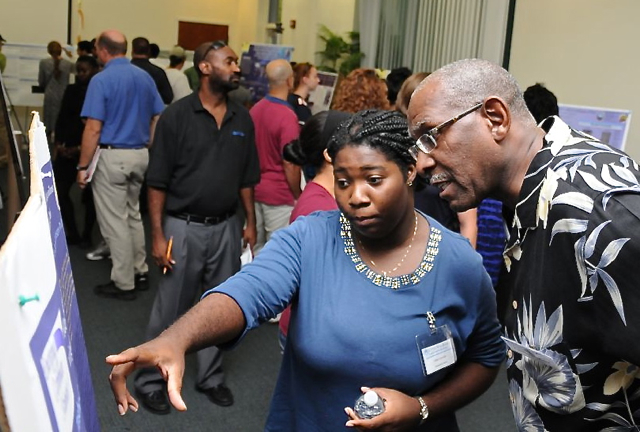
For two hours, a crowd of about 100 people walked among brightly colored poster boards in UVI’s ACC Conference Room on St. Thomas, providing a seemingly endless audience for the smartly dressed student scientists to share their research with.
The research topics represented a range of scientific disciplines, including astrophysics, biology, chemistry and computer engineering. There was also some interdisciplinary collaboration afoot, as some students from different fields teamed up to achieve a common research goal.
Computer engineering senior Anthonios Doliotis and psychology senior Kenisha Pascal did just that as they explored the different dimensions of the correlation between human activity and water quality in the territory.
“One of the biggest threats to our coastal waters in the Virgin Islands is poor water quality,” said Doliotis. “The objective of our research is to describe the importance of good water quality, to present information about watersheds, and to explain how human activity correlates with poor water quality.”
Pascal used socioeconomic data from the 2010 Virgin Islands Census, organized by estate, to examine the relationship between human dimensions and poor water quality. Doliotis used research data from the Environmental Protection Agency, narrowing it down to three manifestations of water impairment: turbidity, fecal coliform and the presence of enterococcus bacteria. Pooling their data, they established strong correlations between poor sanitation systems and water quality in certain watershed, or estates, in the territory.
Doliotis is optimistic that student research findings such as theirs hold promising ‘real-world’ applications.
“This would be very good information to present to DPNR,” he said. “We can say, ‘Look, in these watersheds, these estates have this amount of incomplete plumbing or broken septic systems, and as you can see by our map, it’s affecting our water quality. We need to fix it as soon as possible so we don’t compromise human and animal life.’”
A panel of 23 judges walked from one student station to the next, evaluating student presentations based on the use of visual materials, clarity of the presentation, and the solidity of scientific content. Judges included UVI professors from different scientific fields, including nursing and psychology. John and Pat Shapley, emeritus professors of chemistry from the University of Illinois Urbana-Champaign, as well as VI Department of Education State STEM Director Karissa Poszywak also joined the judges’ panel.
The judging results will be announced in as early as a week, according to organizing committee member Aimee Sanchez.
“We announce the top three scorers,” said Sanchez. “We also provide travel awards to several students to go a national research conference in Washington D.C. called the Emerging Researchers National Conference.”
The number of students who get to attend national research conferences depends on funding, according to Sanchez. In 2012, organizers were able to send nine top scorers of the 14th Fall Research Symposium.
The complexity of scientific student research was not lost on inquisitive onlookers, including UVI president David Hall.
“Like every year, I’m just amazed about the quality,” said Hall, who had just received a thorough briefing from Tasha Corneille on extracting high-quality DNA from ixocid ticks found on white-tailed deer common in the Virgin Islands.
“I think our undergraduate students are doing research that is comparable to any university that I have attended, and I have attended similar research symposia,” added Hall. “I am consistently impressed not only by the type of research, but also by the students’ ability to explain their findings, and the type of support and mentorship that they received from our faculty and from faculty across the country.”
The collection of research displayed at this year’s Fall Symposium was a product of work done during the summer of 2013. UVI students conducted research on both St. Thomas and St. Croix campuses, with support and guidance from well-known scientific institutions, including Johns Hopkins University, Boston University, the University of North Carolina-Chapel Hill, Woods Hole Oceanographic Institution and the Brookhaven National Laboratory in New York, to name a few.
Most of the students’ research was funded by grants, including the National Institutes of Health’s Minority Access to Research Careers (MARC) Program, and its Minority Biomedical Research Support Research Initiative for Scientific Enhancement. The National Science Foundation’s Historically Black Colleges and Universities Undergraduate Program grant also supported the research of some students.
Hall recognized the role played by grants and similar types of funding on spurring scientific research at the undergraduate level.
“I hope that that funding continues to supports our programs so more students can get involved,“ Hall said. “These grants are just a model for how we can get students engaged in research with the type of support that will prompt their careers to go in dynamic places.”